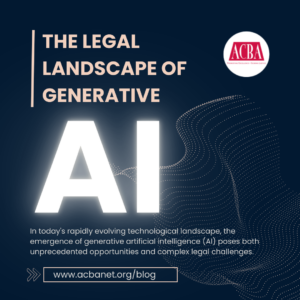In today’s rapidly evolving technological landscape, the emergence of generative artificial intelligence (AI) poses both unprecedented opportunities and complex legal challenges. Generative AI, capable of creating original content such as text, images, and music, has revolutionized various industries, from creative arts to healthcare and finance. However, its widespread adoption also raises significant legal implications that require careful consideration and proactive risk management strategies.
The Legal Landscape of Generative AI
 Generative AI algorithms, powered by deep learning techniques, can generate highly realistic and convincing content that mimics human creativity. While this technology holds immense potential for innovation and efficiency, it also introduces novel legal risks and ethical concerns. It can be helpful as a starting point for everyday communication, but keep in mind that it is not built to deal with legal nuance or context.
Generative AI algorithms, powered by deep learning techniques, can generate highly realistic and convincing content that mimics human creativity. While this technology holds immense potential for innovation and efficiency, it also introduces novel legal risks and ethical concerns. It can be helpful as a starting point for everyday communication, but keep in mind that it is not built to deal with legal nuance or context.
AI has undoubtedly revolutionized various aspects of communication, offering remarkable capabilities in generating first drafts of content efficiently and quickly. In contexts where creativity and fluency are paramount, such as drafting marketing materials, generating blog posts, or crafting social media updates, generative AI can be a valuable tool. It can swiftly produce initial drafts, saving time and effort for writers while providing a foundation for further refinement. Consider how your firm can use these tools for first drafts of marketing emails and blog posts.
However, when it comes to legal documents, the nuances and complexities inherent in the field necessitate a more nuanced approach. While generative AI excels at producing generic text based on patterns learned from vast datasets, it lacks the contextual understanding and legal expertise required for crafting precise and accurate legal documents. Legal communication involves intricate nuances, specialized terminology, and adherence to specific legal frameworks, which can not be adequately captured by AI-generated content.
Furthermore, legal documents require careful consideration of legal precedent, jurisdictional differences, and individual case specifics, all of which demand human judgment and expertise. Generative AI, while capable of producing text based on statistical patterns, cannot fully comprehend the intricacies of legal concepts or the implications of language choices within a legal context.
Privacy and Data Protection
Generative AI algorithms often rely on vast data to train and generate content, raising privacy and data protection concerns. The collection, storage, and utilization of personal data for AI training must comply with stringent privacy regulations, such as the General Data Protection Regulation (GDPR) and the California Consumer Privacy Act (CCPA). Ensuring transparency, consent, and data security throughout the AI development lifecycle is essential to mitigate legal risks and safeguard individuals’ privacy rights. When using AI, consider:
- Avoiding sharing sensitive personal information: Refrain from sharing sensitive personal details such as social security numbers, financial information, or passwords.
- Using generic or anonymized examples: When providing examples or scenarios, use generic or anonymized information instead of real-life details that could identify individuals or organizations.
- Being cautious with proprietary or confidential information: If you’re discussing proprietary business information or confidential details, ensure that you’re not disclosing anything that could compromise your organization’s security or competitive advantage.
- Using general language: When discussing specific situations or experiences, use general language that doesn’t reveal identifiable details about individuals or organizations involved.
- Reviewing privacy settings: Double-check your privacy settings on any platforms or devices you’re using to interact with AI to ensure that your information is protected.
Regulatory Compliance: In response to the rapid advancement of AI technologies, governments, and regulatory bodies are increasingly scrutinizing the legal and ethical implications of generative AI. From industry-specific regulations to broader ethical guidelines, navigating the evolving regulatory landscape requires a comprehensive understanding of AI governance frameworks and compliance obligations. Firms must proactively assess and address regulatory requirements to mitigate legal risks and ensure responsible AI deployment.
Keep up-t0-date on regulatory requirements to using AI by becoming a member of legal associations like the Alameda County Bar Assoication (ACBA). Organizations like the ACBA often provide resources, live webinars and on demand courses, and networking opportunities to stay informed about regulatory developments and best practices in AI governance. ACBA members also have access to the ABCA Listserv where you can ask your colleagues questions about how they are navigating the ethical use of AI.
As generative AI continues to reshape the legal landscape, organizations, and legal practitioners must proactively address the legal risks and ethical challenges inherent in AI-driven innovation. By adopting a proactive approach to risk management and staying informed about evolving regulatory requirements, firms can harness the transformative potential of generative AI while mitigating legal risks and upholding ethical standards.
